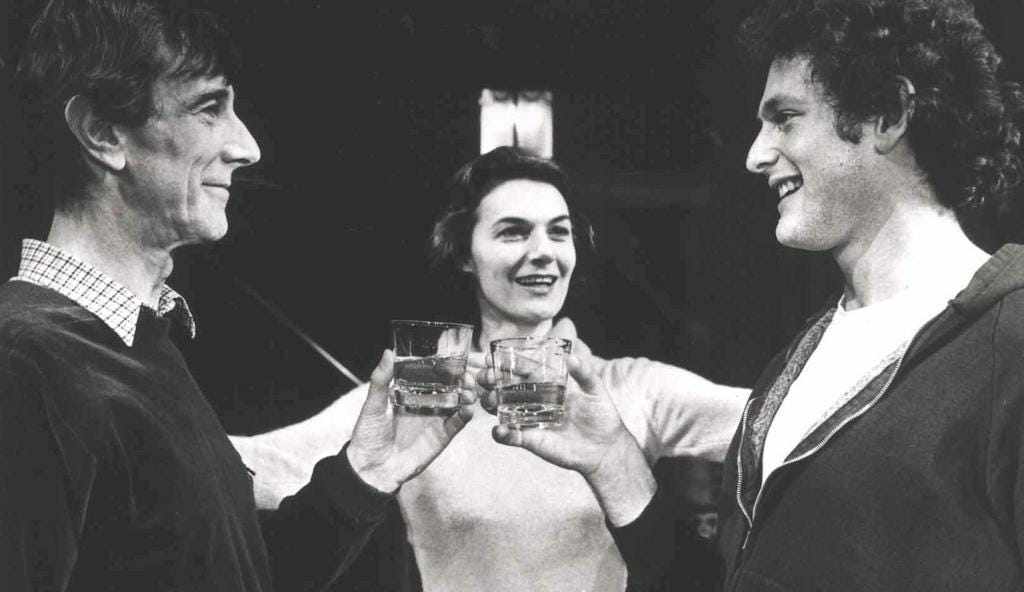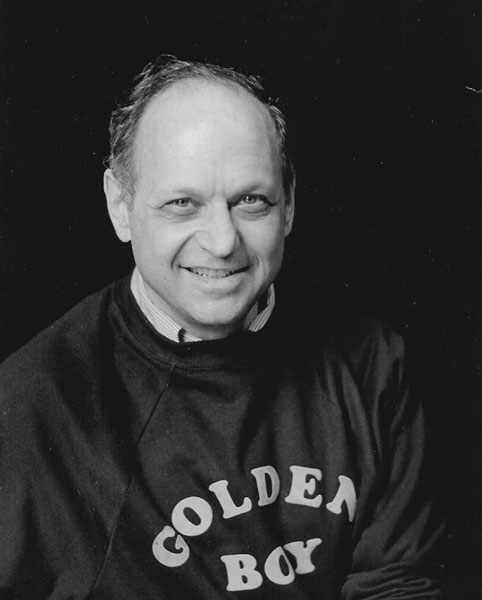
Possessing one of the most indelible personas marking Hollywood's Golden Age, Humphrey Bogart's unique charisma continues to persist in our collective conscience as many as sixty-four years after his death. While smoking an endless chain of cigarettes, he effortlessly romanced the likes of Ingrid Bergman and Lauren Bacall, whom he starred opposite when she was nineteen and would marry a year later. Movie star that he was, like many of his cinematic contemporaries (Cary Grant, Clark Gable and Spencer Tracy, to name a few), he began his creative life on stage, appearing in seventeen Broadway shows between 1922 and 1935. Here are some stories about those mostly forgotten thirteen years in this edition of "Theatre Yesterday and Today."
Humphrey DeForest Bogart was born in New York City on Manhattan's Upper West Side on the last Christmas of the twentieth century, December 25, 1899 (the townhouse, still standing, is one block directly behind my current residence). Like much of a good deal of biographical information on him, it has been questioned whether his birthday was made up for publicity purposes, but my research indicates it's true. The famous scar over his lip also brings up different stories over its origin, with it being attributed to everything from a wound he received during his stint in World War I, to a bottle being broken across his face in a bar fight. The silent screen star Louise Brooks, who knew Bogart well during his earliest days as a young actor, wrote about that scar in a rather loving entry in her autobiography Lulu in Hollywood: "His handsome face was made extraordinary by a beautiful mouth. It was very full, rosy, and perfectly modeled — perfectly, that is, except that, to make it completely fascinating, at one corner of his upper lip a scarred, quilted piece hung down in a tiny scallop. When Humphrey went into films, a surgeon sewed up the scallop, and only a small scar remained. Photographically, it was an improvement, but I missed this endearing disfigurement. The scar on his lip has since become a symbol of his heroism."


Bogart was born to privilege by parents who were educated and who both earned good livings. In addition to their Manhattan home, the family owned a sprawling 55-acre estate, Willow Brook, on the shore of Canandaigua Lake in Seneca Point in upstate New York. His father was a doctor and his mother an artist of national reputation. It was Maud Bogart who used young Humphrey as a child model, which garnered him ads in magazines for such products as Mellins Baby Foods (not Gerber, as has often been reported). “There was a period in American history when you couldn’t pick up a goddamed magazine without seeing my kisser in it,” the actor later said. Educated at the best schools, Bogart was a poor student, lazy by his own admission, and kicked out of the exclusive prep school, Phillips Academy—Andover, in Massachusetts. The discipline he sought and needed came when he enlisted in the Navy in 1918.


It should be stated that the only wartime action Bogart saw (contrary to stories written by the studio publicity departments) was when an officer decked him in the face for talking back.
At first, he drifted, not knowing to what profession he might be best suited. A stint as an assistant stage manager gave him the mind to try his hand at acting, and he wound up with doubling up in a play appropriately titled Drifting, for which one role had him cast as a Japanese butler! Billed as H.D. Bogart, the play closed quickly in early 1922, but it introduced him to the actor Robert Warwick, who expressed a fatherly manner towards the young Bogart. Years later, when Warwick was down on his luck, Bogart made sure he got a meaty supporting part in 1950's In a Lonely Place, which featured one of Bogart's most complex leading roles.
Later that year, Humphrey Bogart's name first appeared in a program in a comedy titled Swifty (funny in that Irving "Swifty" Lazar, who became Bogart's Hollywood agent years later, was forever known by that nickname — which Lazar couldn't stand and was coined by Bogart). Swifty was where Bogart first played the role of an affluent, not particularly brainy young man, that he would come to despise. Perhaps that was due to critics such as Alan Dale who noted that Bogart "gave some rather trenchant exhibitions of bad acting." Also, Alexander Woolcott, somewhat notorious in his day for possessing a poison pen, dubbed Bogart's acting "what is usually and mercifully described as adequate."
Two years later, when Bogart appeared in another minor comedy titled Nerves, Woolcott came not to bury Bogart, but to praise him. "Those words," referring to his previous review, "are hereby eaten."
The handsome young man roles continued, with some accounts crediting him with being the first to bounce on stage with a racket and utter the immortal line "Tennis, anyone?" Though that story, like so much else, is more rooted in fiction than fact.
Finally, in 1925, Bogart was in a hit, receiving third billing in Cradle Snatchers, which ran for 478 performances. In the New York Times review, Bogart was pointed out as "pleasing." And though it was nice to have a steady job, he was unsatisfied.

Along the way he got briefly married to an actress, Helen Menken, a rising star on the stage, then later to Mary Philips, to whom he would later play opposite in 1929's Skyrocket, the first play in which he starred. It ran 11 performances.

In 1927, Bogart appeared in Baby Mine, a comedy that was designed to resuscitate the career of silent screen star Roscoe "Fatty" Arbuckle, for whom this marked his one appearance on the Broadway stage. It flopped, running a mere dozen performances, one more than Skyrocket.
After a few more plays, Bogart sought greener pastures in Hollywood in 1930. His handsome face and unique vocal qualities seemed like the right combination for stardom, but it eluded him. The roles he got were squarely in the leading man category, but perhaps at twenty-nine, he was still a bit too callow. They did little to distinguish his resume, although he was getting a crash course in film acting, working opposite some terrific live wires such as Bette Davis, and in Up the River, a young Spencer Tracy, who would become a lifelong friend and be the person responsible for giving Bogart the nickname "Bogie."
He returned to New York in 1934 to be at the bedside of his dying father, which though tragic, aided his career through propitious timing. A Broadway producer thought of Bogart while looking for an actor to portray a John Dillinger-like gangster in a new play by Robert E. Sherwood, one of the biggest playwrights of the day. The Petrified Forest starred Leslie Howard, the British actor who would forever be known for playing Ashley Wilkes in Gone With the Wind, and both he and Bogart received excellent reviews. Though it was a role Howard could have done in his sleep, Bogart had never played a ruthless character like this before and critics woke up to his talents. John Mason Brown wrote "he cuts loose from the suave young worldlings he has played with varying success, to act the killer in an excellent and quietly dominating 'tough guy' way." His unshaven stubble was as much a sensation as his performance.

When the film version was being readied by Warner Bros. in Hollywood a year later, the studio wanted one its leading contract players (and resident tough guy) Edward G. Robinson in Bogart's part, but it was Leslie Howard (already signed to recreate his role) who made sure it was Bogart who got to play Duke Mantee. Howard had the clout to make it happen since his contract gave him final script control. And when it became a big hit, it served to re-launch Bogart's career in film, forever keeping him on the West Coast, never to perform on stage again. For this act of kindness, Bogart remained indebted to Howard, who tragically died during World War II when the plane he was in that was heading for London was shot down by the German Luftwaffe. Years later, Bogart named his only daughter Leslie Howard Bogart in his late friend's memory.
The clip below from The Petrified Forest should give you an idea of Bogart's presence (and possibly how he played it on stage). Already thirty-five, he was beginning to mature into the actor he would soon become with performances in The Maltese Falcon, High Sierra and Casablanca. That 1943 classic, mostly due to his chemistry with Ingrid Bergman, turned him into the wounded romantic for which he would become world famous. It's sad to think that after Casablanca, Bogart only had fourteen more years of movie stardom. In his final film, The Harder They Fall, released in 1956, he looked gaunt and aged, far older than he actually was. He died of esophageal cancer (those damned cigarettes), just after his fifty-seventh birthday.
Also, a shout out to my friend and colleague Samuel L. Leiter, distinguished professor emeritus of Brooklyn College, for invaluable information by way of his volumes titled Encyclopedia of the New York Stage, which aided immeasurably in this reporting.
If you enjoy these columns, check out Up in the Cheap Seats: A Historical Memoir of Broadway, available at Amazon.com in hardcover, softcover and e-book. And please feel free to email me with comments or questions at Ron@ronfassler.org.





















Write a comment ...